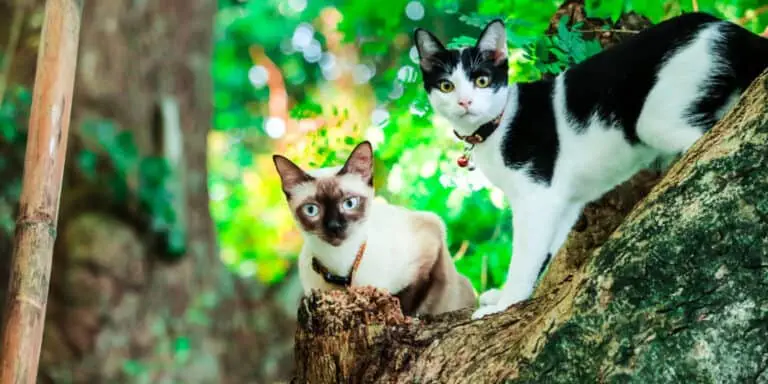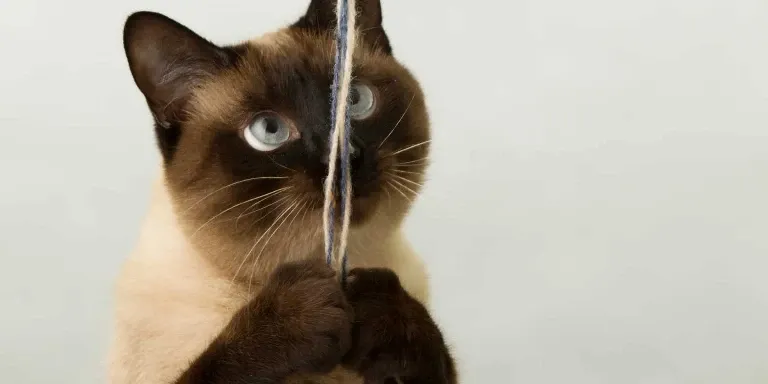The Best Fluffy Pancakes recipe you will fall in love with. Full of tips and tricks to help you make the best pancakes.

You may have heard that Siamese cats are more clingy than other breeds. Perhaps this has turned you off from considering a Siamese cat as a pet. However, before making any assumptions, it’s important to understand the behavior and personality traits of this unique breed.
Siamese cats are known to be more social and affectionate compared to other cat breeds. They tend to form strong bonds with their owners and enjoy being around them. This can make them appear more clingy, as they often seek attention and companionship. However, it’s important to note that individual personalities can vary, so not all Siamese cats will be clingy.
As with any animal, it’s important to approach Siamese cats with an open mind and a willingness to learn. By understanding their behavior and needs, you can create a strong bond with your furry friend and provide them with the love and care they require.
So, let’s dive into the world of Siamese cats and explore whether or not they are, in fact, more clingy than other breeds.
Understanding Cat Behavior
Do you ever wonder why your cat acts the way they do, and what their behavior means? Understanding cat behavior is essential in building a strong bond with your pet.
One of the most important aspects of cat behavior is body language. Paying attention to your cat’s body language can help you interpret their moods and feelings. For instance, if your cat’s ears are flattened, and their body is tense, it could mean that they’re feeling threatened or scared.
Another essential aspect of cat behavior is dealing with aggression. Cats can become aggressive for various reasons, such as fear, frustration, or territorial behavior. If your cat is displaying aggressive behavior, it’s important to understand the cause and address it accordingly.
For example, if your cat is feeling threatened by another cat, providing separate living spaces and gradually introducing them can help reduce aggression. Understanding cat behavior is crucial in building a healthy relationship with your pet.
By paying attention to their body language and addressing any aggressive behavior, you can create a loving and comfortable environment for your furry friend. Remember to always approach your cat with patience and kindness, and they’ll reward you with their love and affection.
The Siamese Cat Breed
When it comes to the Siamese cat breed, you may be wondering about their appearance and unique characteristics.
Siamese cats are easily recognizable with their striking blue eyes and sleek, muscular bodies. They are also known for their vocal and affectionate nature, making them a popular choice among cat owners.
Siamese cats are believed to have originated from Thailand and were once considered sacred animals in their native land.
Appearance and Characteristics
Siamese cats have a distinctive appearance, with their sleek bodies and striking blue eyes, that makes them stand out from other breeds.
Siamese cat appearance is characterized by their pointed ears, long tails, and angular heads. Their distinguishing features include a light-colored coat with darker points on their face, ears, paws, and tail. These points can come in a variety of colors, including blue, chocolate, lilac, and seal. The Siamese cat breed also has a unique body shape, with a long, slender, and muscular frame that is built for agility and speed.
Aside from their physical appearance, Siamese cats also have distinct behavioral traits. Siamese cat behavior is characterized by their body language and communication cues. They’re known for being vocal and expressive, often meowing and purring to communicate with their owners.
Siamese cats are also known for being affectionate and social, often following their owners around and seeking attention. Their clingy behavior has led some people to believe that Siamese cats are more dependent than other breeds, but this isn’t necessarily the case. Siamese cats can be independent, but they do require a lot of attention and affection from their owners to thrive.
Historical Background
The historical background of this breed goes back several centuries, with evidence of Siamese cats being kept in the royal households of Siam, now known as Thailand.
In fact, these cats were highly regarded and even considered sacred by the people of Siam.
Siamese cats were often given as gifts to visitors of the royal court and were even used as guard cats to protect the king’s treasures.
The Siamese cat’s cultural significance continued to grow, as they were eventually brought to Europe and America in the late 1800s.
These cats quickly became popular for their unique appearance and playful personalities.
Today, Siamese cats are still a beloved breed and are known for their intelligence, loyalty, and affectionate nature.
While their clinginess may vary from cat to cat, it’s clear that the Siamese cat’s rich history has contributed to their reputation as a loving and devoted companion.
Siamese Cat Personality Traits
As you delve into the subtopic of Siamese cat personality traits, it’s important to note that these felines are known for being affectionate and attention-seeking. They thrive on human interaction and have a reputation for being vocal and demanding when they want attention.
In addition to their social nature, Siamese cats are also highly intelligent and playful, making them a popular choice among cat owners who appreciate their active and engaging personalities.
Affection and Attention Seeking
You’ll find that with their affectionate nature, Siamese cats are always seeking attention from their owners. They crave physical contact, and they will follow you around the house, meowing for your attention. This is because they’re social creatures that thrive on human interaction.
Siamese cats have a strong desire to be near their owners and show their love through constant affection. However, this clinginess can sometimes become overwhelming, especially when you have a busy schedule.
To handle attention-seeking behavior, it’s essential to spend quality time with your Siamese cat every day. Make time for play, cuddles, and grooming sessions. This will not only give your cat the affection and attention they crave but also strengthen the bond between you and your feline friend.
Additionally, providing toys, scratching posts, and other interactive activities can help keep your Siamese cat entertained and prevent them from becoming overly clingy.
Vocalization
Vocalization is a prominent trait in the Siamese breed, with studies showing that they produce a wider range of vocalizations compared to other domesticated cats. They’re known to be vocal and expressive, with a distinctive voice that’s often described as sounding like a human baby crying.
Siamese cats use their voice to communicate with their owners, seeking attention, affection, or simply expressing their emotions. However, excessive vocalization can be a problem for some Siamese cat owners. If your cat is keeping you up at night with their constant meowing, there are ways to reduce their vocalization.
The first step is to identify the triggers of their vocalization. Siamese cats may meow when they’re hungry, bored, anxious, or seeking attention. Once you identify the trigger, you can address the underlying issue and reduce their need to vocalize. Providing your Siamese cat with plenty of toys, playtime, and affection can also help reduce their vocalization.
Intelligence and Playfulness
Now that we’ve discussed the vocalization of Siamese cats, let’s dive into their intelligence and playfulness.
Siamese cats are known to be highly intelligent, ranking third in intelligence among all cat breeds. They are quick learners and can be trained to do tricks and follow commands. This intelligence also makes them more curious and adventurous than other breeds, often leading them to explore and get into mischief.
To keep your Siamese cat mentally stimulated, it’s important to provide them with interactive toys and games. Puzzle feeders, laser pointers, and feather wands are all great options to keep them entertained and mentally engaged. Siamese cats also enjoy playing fetch and can be trained to retrieve toys like a dog.
By providing mental stimulation and playtime, you can prevent your Siamese cat from becoming bored and destructive. So, make sure to keep them entertained with plenty of interactive toys, and your Siamese cat will be a happy and well-behaved companion.
Comparing Siamese Cats to Other Breeds
When comparing Siamese cats to other breeds, you’ll find both similarities and differences.
Personality profiles are a key factor in these comparisons, as each breed has its own unique traits.
As a knowledgeable observer, you understand that studying these traits is essential for understanding the behavior and needs of different breeds.
Similarities and Differences
One noticeable difference between Siamese cats and other breeds is their increased level of clinginess. Siamese cats crave attention and affection from their owners and will often follow them around the house, meowing for attention. They are known for being very vocal and demanding, and can become anxious and upset if they’re left alone for too long.
This is in contrast to other breeds, such as the Persian or the Maine Coon, which tend to be more independent and self-sufficient. Despite their clinginess, Siamese cats do have some similarities to other breeds. Like all cats, they are curious and playful, and enjoy exploring their surroundings. They also have a reputation for being intelligent and trainable, and can learn tricks and commands just like dogs.
However, their unique personality traits, such as their high level of clinginess, make them stand out from the crowd and endear them to many cat lovers.
Personality Profiles
Personality profiles of feline companions can vary greatly, and understanding the unique traits and tendencies of different breeds can help owners choose the perfect cat for their lifestyle.
Personality testing is one way to help identify a cat’s behavioral patterns, and this can be particularly useful when selecting a Siamese cat. Siamese cats are known for being incredibly social and outgoing, and they often crave attention and affection from their owners. They’re intelligent and curious, and they love to explore their surroundings and play with toys.
However, they can also be demanding and vocal, and they may become anxious or destructive if they’re left alone for extended periods of time. Overall, Siamese cats are a great choice for those who want a companion that’s loving, playful, and interactive.
The Role of Socialization and Training
To train your siamese cat to be less clingy, try incorporating consistent socialization into their schedule. It’s important to expose them to different environments, people, and animals from an early age. This will help them become more confident and independent, reducing their need to cling onto their owners. Positive reinforcement training techniques can also help in this process. Reward your cat for exhibiting independent behavior and discourage clinginess by ignoring the behavior or redirecting their attention elsewhere.
Here are some tips to help you socialize your siamese cat effectively:
- Start socialization early. The first few months of a kitten’s life are critical for their social development. Expose your siamese cat to different people, animals, and environments during this time.
- Use positive reinforcement. Reward your cat with treats and praise when they exhibit independent behavior. This will help them associate independence with positive outcomes.
- Be patient. Socialization takes time and patience. Don’t force your cat into situations they’re uncomfortable with, but gently encourage and expose them to new experiences.
By incorporating consistent socialization and positive reinforcement training techniques, you can help your siamese cat become less clingy and more independent. Remember to be patient and gentle in the process, and to reward your cat for exhibiting independent behavior. With time and effort, you can help your siamese cat become a happy and well-adjusted member of your family.
Understanding Your Siamese Cat’s Needs
Understanding your Siamese cat’s needs is essential for building a strong relationship with your furry friend and maintaining their health. One crucial aspect of understanding your Siamese cat’s needs is learning to decode their unique communication style. Siamese cats are known for their vocalizations and tendency to follow their owners around. This behavior isn’t necessarily a sign of clinginess; it’s merely their way of expressing their desire for attention and affection.
Another essential aspect of understanding your Siamese cat’s needs is providing them with mental stimulation. Siamese cats are highly intelligent and require regular mental exercises to keep them engaged and happy. Interactive toys, puzzle feeders, and regular play sessions are all excellent ways to provide mental stimulation for your Siamese cat. Without adequate stimulation, Siamese cats may become bored, anxious, or even destructive.
Understanding your Siamese cat’s needs means taking a holistic approach to their well-being. This includes providing them with proper nutrition, regular veterinary care, and a safe, comfortable home environment. Siamese cats thrive in a calm, quiet home with plenty of places to climb, hide, and play.
By meeting all of your Siamese cat’s needs, you can create a strong bond with your furry friend and ensure their long-term health and happiness.
Addressing Clinginess and Separation Anxiety
If you’ve been enjoying the company of your Siamese cat, you may have noticed that they can be quite demanding of your attention. Understanding your Siamese cat’s needs is crucial in maintaining a healthy relationship with them. However, sometimes their clinginess can become overwhelming, leading to separation anxiety and other behavioral issues.
If you’re struggling with a clingy Siamese cat, it’s important to address their behavior and find coping mechanisms to help both you and your pet. One approach is to set boundaries and establish a routine that includes alone time for your cat. This can be achieved by providing them with toys and activities to keep them occupied while you’re away.
If your cat’s clinginess persists or becomes more severe, it may be time to seek professional help. A veterinarian or animal behaviorist can assess your cat’s behavior and provide guidance on how to manage their separation anxiety. They may also suggest medication or other treatments to help your cat cope with their anxiety and improve their overall well-being.
Remember, addressing your Siamese cat’s clinginess is important for both you and your pet’s happiness and health.
Do Siamese Cats Require More Attention Than Other Breeds?
Siamese cats have special characteristics that make them more attention-seeking than other breeds. They are social and vocal, often demanding interaction from their owners. Their high intelligence also means they get bored easily, so they benefit from engaging toys and regular play sessions to keep them stimulated and happy.
Final Thoughts
We hope you found it informative and helpful in understanding the unique personality traits of this beloved breed.
While some may view their clinginess as a negative trait, it’s important to remember that it simply means they have a strong bond with their human companions. With proper socialization and training, you can help your Siamese cat feel more comfortable and confident when left alone.
Remember, just like any other pet, Siamese cats have their own individual needs and personalities. By understanding and meeting those needs, you can create a happy and fulfilling relationship with your feline friend.
So go ahead and give your Siamese cat a cuddle – they’ll love you for it!








